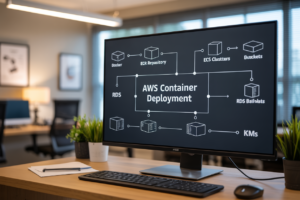Ever spent hours staring at standard Salesforce components wishing they’d just work the way your business actually operates? You’re not alone. Every day, thousands of Salesforce admins waste countless hours on workarounds for what should be simple customizations.
Lightning Components are about to become your new best friend. With this step-by-step guide, you’ll learn how to build custom Salesforce Lightning Components that perfectly match your unique business processes—no more forcing square pegs into round holes.
I’ve helped dozens of companies transform their clunky Salesforce instances into streamlined powerhouses with custom Lightning Components. From basic field modifications to complex interactive elements that make users actually enjoy logging in.
But here’s the thing most tutorials won’t tell you about Lightning Components…
Understanding Lightning Components Fundamentals
What Are Lightning Components and Why They Matter
Lightning Components are reusable UI elements that power Salesforce’s modern interface. Think of them as LEGO blocks for your Salesforce org – snap them together to build stunning apps without starting from scratch. They’re game-changers because they deliver consistent experiences across devices while dramatically speeding up development time.
Comparing Lightning Components with Visualforce
| Feature | Lightning Components | Visualforce |
|---|---|---|
| Architecture | Component-based | Page-based |
| Mobile-readiness | Built-in | Requires extra work |
| Performance | Faster client-side | Server-side processing |
| Development | Modern JavaScript | MVC pattern |
| User Experience | Modern, responsive | Traditional, can be clunky |
Benefits of Custom Lightning Components for Your Organization
Custom Lightning Components transform how your team works. They slash development time by creating reusable building blocks, ensure brand consistency across your entire Salesforce ecosystem, and boost user adoption with slick interfaces. Plus, they future-proof your investment as Salesforce continues its Lightning-first approach.
Setting Up Your Development Environment
A. Installing and Configuring Salesforce CLI
Got a Mac? Run brew install salesforce-cli. Windows user? Download the installer from Salesforce’s website. After installation, open your terminal and run sf login to connect to your org. Trust me, this step saves hours of manual work later when you’re pushing components to production.
B. Setting Up Your IDE (VS Code with Salesforce Extensions)
Download VS Code (it’s free), then hit the Extensions marketplace icon on the left sidebar. Search for “Salesforce Extension Pack” and click install. This pack gives you syntax highlighting, code completion, and direct deployment capabilities. Restart VS Code, and you’re ready to rock.
C. Creating Your First Lightning Component Bundle
In VS Code, press Cmd+Shift+P (or Ctrl+Shift+P on Windows) and type “SFDX: Create Lightning Web Component.” Enter a name, select a folder, and boom—your component structure appears. The main files you’ll work with are the HTML template, JavaScript controller, and CSS file.
D. Understanding Component Naming Conventions
Lightning components use camelCase for files (myAwesomeComponent) but kebab-case in HTML (my-awesome-component). Always start component names with lowercase letters. Avoid generic names like “button” or “card”—use descriptive prefixes like “account-detail-card” instead. Your future self will thank you.
Building Your First Lightning Component
Creating the Component Structure (HTML, JavaScript, CSS)
Diving into Lightning Components isn’t rocket science. You’ll need three core files: component markup (HTML), controller (JavaScript), and styling (CSS). Think of them as the skeleton, brains, and clothes of your component. Open Developer Console, hit “New,” select “Lightning Component,” name it, and boom – you’re off to the races.
Advanced Lightning Component Development
Working with Apex Controllers
Apex controllers are the backbone of your Lightning components’ server-side logic. They’re not just fancy middleware—they’re where the real magic happens. Want to query complex data sets or integrate with external systems? That’s where Apex shines. Just create your controller class, add @AuraEnabled methods, and you’re cooking with gas.
Integrating Components into Salesforce
Integrating Components into Salesforce
A. Adding Components to Lightning Pages
Got your components ready? Great! Now drag and drop them right onto your Lightning Pages. It’s honestly that simple. Select your page, find your custom component in the sidebar, and plop it where you need it. No coding required here—just point, click, and watch your component come to life.
B. Using Lightning App Builder
C. Creating Custom Lightning Apps
D. Embedding Components in Lightning Record Pages
Performance Optimization and Best Practices
Improving Component Load Time
Let’s cut to the chase – slow components kill user experience. Strip unnecessary JavaScript, optimize CSS, and use fewer nested components. Cache data when possible and implement server-side pagination for large datasets. Your users will thank you when your app loads in milliseconds instead of seconds.
Debugging and Troubleshooting
Using Console Debugging Tools
Ever banged your head against the wall trying to find that pesky bug? Chrome DevTools is your new best friend. Just hit F12, navigate to the Console tab, and use console.log() statements strategically in your JavaScript controller. Trust me, it’s a game-changer for tracking component lifecycle events.
Deploying Lightning Components
Deploying Lightning Components
A. Moving Components Between Environments
Ever tried moving your shiny new Lightning Component to production only to watch it crash and burn? Been there. Moving components between environments isn’t just copying and pasting code—it’s an art form. You’ll need to package your components with all their dependencies and configuration settings intact to avoid that dreaded “component not found” error.
B. Change Set Deployment Process
Change sets are your basic transportation system for Lightning Components. Create an outbound change set in your source org, add your components, upload it, then validate and deploy in your target org. Sounds simple, right? The tricky part is remembering all those dependent components—miss one and you’re back to debugging.
C. Using SFDX for Deployment
SFDX kicks deployment into high gear. With a few command-line instructions, you can push components across environments without breaking a sweat. Just set up your project, authenticate your orgs, and run sfdx force:source:push. It’s faster, more reliable, and makes you look like a deployment wizard to your colleagues.
D. Managing Component Dependencies
Component dependencies will make or break your deployment. One forgotten custom field and your whole component falls apart. Create a dependency map before deployment—track custom objects, fields, permissions, and other components your Lightning Component references. This extra step saves hours of post-deployment troubleshooting.
Lightning Components represent a powerful way to customize and enhance your Salesforce experience. Throughout this guide, we’ve explored the fundamentals of these components, walked through setting up your development environment, and demonstrated how to build and integrate both basic and advanced components into your Salesforce instance. We’ve also covered essential practices for optimization, debugging, and successful deployment.
As you begin implementing Lightning Components in your own Salesforce org, remember that the learning curve is worth the investment. The flexibility and functionality they provide can significantly improve user experience and operational efficiency. Start with simple components to build your confidence, leverage the debugging tools we’ve discussed when challenges arise, and always follow the performance best practices to ensure your customizations enhance rather than hinder your Salesforce experience. The power to transform your Salesforce instance is now in your hands!




















